Gubbins D., Herrero-Bervera E. Encyclopedia of Geomagnetism and Paleomagnetism
Подождите немного. Документ загружается.


Another type of paleomagnetic sample is collected by the simpler
method of orienting a block of the outcrop that is later broken and
labeled. These types of samples are commonly collected when the
lithology is not suitable for coring. There are logistic complications
for transporting the coring equipment (including water and gasoline)
to the outcrop, there are laws forbidding the use of coring equipment
(as for example in some national parks or reserve areas), or in despera-
tion when the coring equipment breaks down in the middle of a field
season. Although simpler in logistics, this method of sample collection
is not as good as the coring method because of the limitations in the
accuracy of orientation and on the need of collecting joint blocks that
are more likely to have been affected by weathering than the massive
portions of the outcrop. It also requires carrying of an excess material
that has to be thrown away after specimens have been sliced out of the
sample in the laboratory.
The third main type of paleomagnetic sample is collected in the
form of core sample obtained from lake- or sea-bottom cores or from
exploration wells. These samples are typically 10 cm diameter and
can be from a few meters to some hundreds of meters and even kilo-
meters long. There are two main types of coring techniques in this
category: piston coring (in which the bit is introduced forcefully into
the sediment) and rotary drills (similar in all respects to the first type
of samples discussed above, but with drills that are much larger and
not likely to be handled by just one bare-handed operator). Both types
of cores are commonly azimuthally unoriented and the direction of the
core is assumed to be vertical. Evidently, these types of samples pro-
vide less reliability in terms of accuracy of orientation, which often
involve the operation of expensive machinery and may not yield
recovery of the entire core, but as already mentioned they can be the
only access to one particular rock unit.
In some particular situations, paleomagnetic samples can be col-
lected by using very specific (and sometimes very ingenious) methods
that often combine some aspects of the three main types just men-
tioned. For example, loose sediments that are accessible in outcrop
cannot be suitable for drilling or for block sampling. In this case, sam-
ples can be collected by inserting small plastic boxes in the sediment
and orienting them before removing the material around to retrieve
the box. Some degrees of impregnation with an epoxic resin might
also be used for this purpose, or any other method that allows the
operator to retrieve a reasonably well oriented sample.
In summary, the most important aspect to have in mind when col-
lecting samples for any paleomagnetic work is the ability to orient
the samples. Although in some circumstances the orientation must be
necessarily limited to a distinction between the up and down direc-
tions, therefore limiting the utility of such samples.
Edgardo Cañón-Tapia
Cross-references
Paleomagnetism
PALEOMAGNETIC SECULAR VARIATION
The source of the Earth’s magnetic field has been the subject of scien-
tific study for more than 400 years (e.g., Gilbert, 1600). At present we
believe that most of the field measured at the Earth’s surface is of internal
origin, generated by hydromagnetic dynamo action in the liquid-iron
outer core. Historic measurements of the geomagnetic field have docu-
mented its primarily dipolar spatial structure at the Earth’s surface
and its temporal variability, which is termed as secular variation. One
notable characteristic of the Earth’s magnetic field and secular variation
is its full vector nature, with significant space-time variability in
both directions and intensity. Recent historic secular variation (HSV)
studies (e.g., Thompson and Barraclough, 1982; Bloxham and Gubbins,
1985. Olson et al., 2002) have characterized the global pattern of
short-term secular variation and have related its variability to the core
dynamo process.
Paleomagnetic studies make it clear, however, that the Earth’s mag-
netic field has undergone a wider range of temporal and spatial varia-
bility than has been seen in historic times. Geomagnetic field polarity
reversals have occurred intermittently in time (e.g., Cande and Kent,
1995) and the intervening time intervals of stable dipole polarity con-
tain paleomagnetic secular variation (PSV) larger in amplitude and
broader in frequency content than HSV. PSV studies have also docu-
mented occasional excursions (Watkins, 1976; Verosub and Banerjee,
1977), which are anomalous PSV fluctuations that may be aborted
polarity reversals or represent a fundamentally different multipolar
state of the geomagnetic field (Lund et al., 1998, 2001).
PSV is estimated from the paleomagnetic study of archeological
materials, unconsolidated sediments, and rocks. The paleomagnetic
methods used to recover PSV data are well documented (e.g., Butler,
1992. Tauxe, 1993. Merrill et al., 1998; Dunlop and Özdemir, 2001),
and everyone noticed that rather different methods are normally used
to recover estimates of paleomagnetic field direction and intensity.
Therefore, historically, PSV directional data usually do not have asso-
ciated paleointensity estimates and vice versa. However, over the last
decade that tendency has finally been balanced by the development
of numerous high-resolution full-vector PSV records.
This article surveys our current knowledge of PSV; it will provide
an overview of PSV data sources, methods of PSV analysis, long-term
characteristics of PSV, and models for PSV behavior. The survey will
discuss both intensity and directional variability. Special attention
will be paid to the relationship between PSV and HSV, the evidence
for or against long-term stationarity of PSV, the relationship of PSV
to excursions, and the characteristics of PSV that may be useful in
dynamo studies.
PSV data
PSV data come from a wide variety of paleomagnetic studies that can
be separated into three groups based on the type of sediment or rock
measured, the degree of detail in stratigraphic sampling, and the
degree of age control for each study. The three resulting PSV data
groups are (1) studies of Quaternary-aged sequences of unconsolidated
sediments, lava flows, or archeological materials, which can be dated in
detail by radiocarbon methods or oxygen isotope stratigraphy, and
which are sampled in detail sufficient to resolve the temporal pattern
of PSV variability (termed waveform information); (2) studies of older
sediment or lava flow sequences that have waveform information but
no detailed age control; and (3) studies of any aged rock or sediment
sequences that have poor within sequence age control and no wave-
form information (sequential data are not serially correlated). The first
type of PSV study can be used for a full spectrum of time series ana-
lyses (waveform, spectral, or statistical analyses); the second type of
study can be used for waveform and statistical analyses; the third type
of study is only suitable for statistical analysis.
The materials normally used for detailed paleomagnetic studies of
PSV are archeological materials (kilns, fire pits, etc.), lava flows, and
lake or marine sediment sequences. Each of these materials has inherent
advantages and disadvantages for the accurate recording of PSVand the
accumulation of paleomagnetic records from all three materials in par-
allel is the ideal way to establish regional patterns of PSV. Figure P9
illustrates the use of multiple PSV records derived from multiple
766 PALEOMAGNETIC SECULAR VARIATION
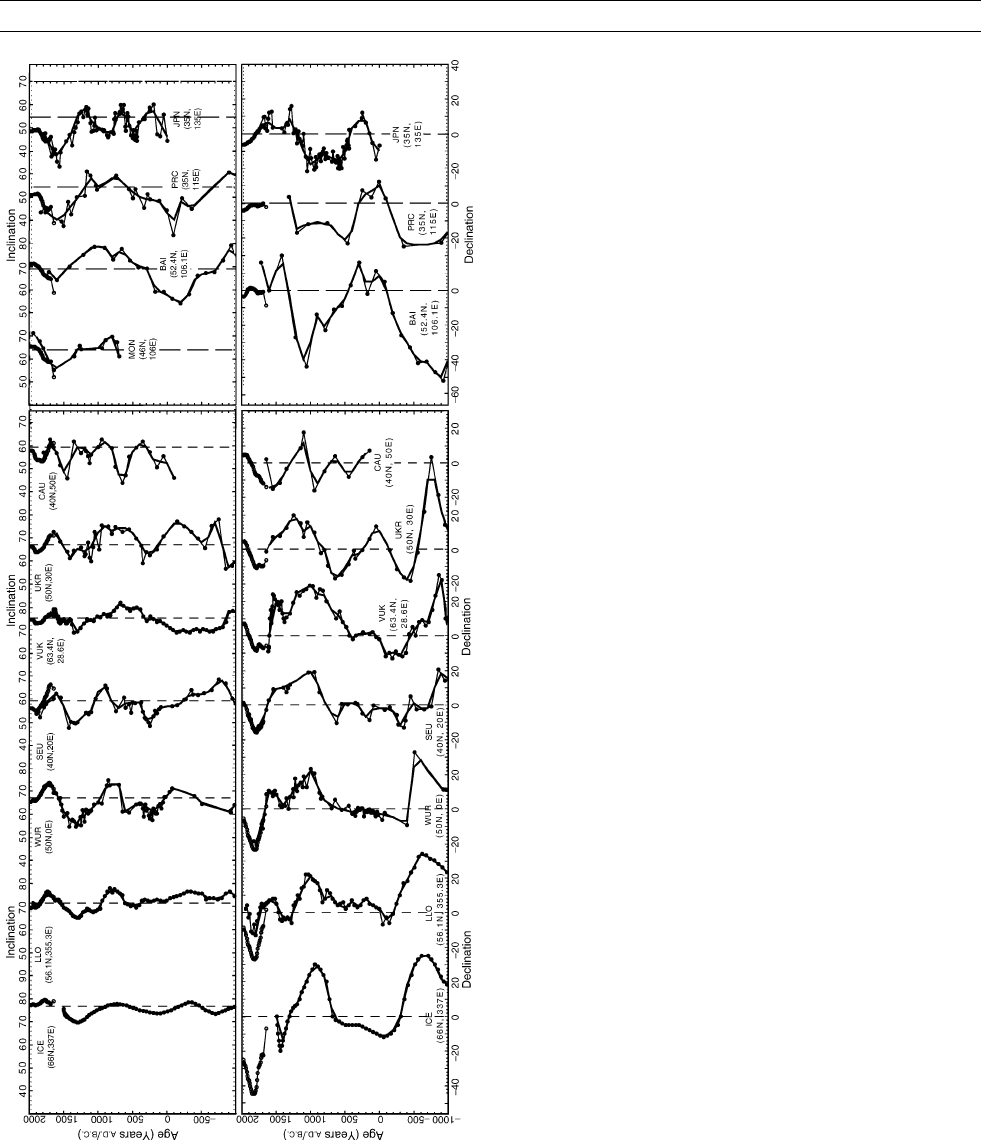
data sources (data summarized in Constable et al., 2000) to recon-
struct the paleomagnetic directional variability across Eurasia for
the last 3 ka. PSV records ICE, Loch Lomand, Scotland (LLO),
Lake Vukonjarvi, Finland (VUK), and Lake Baikal, Russia (BAI)
are derived from lake sediment sequences, while the other six
PSV records are based on archeological and lava-flow measure-
ments. The solid dots in Figure P9 are the actual paleomagnetic
measurements, the heavy solid lines are interpolated equi-spaced
time series (PSVMOD1.0, available at http://earth.usc.edu/ slund),
and open circles in the most recent 400 years are estimated historical
secular variation based on spherical harmonic analysis.
Lava flows and archeological materials have the advantage that their
natural remanent magnetization (NRM) is normally a thermoremanent
magnetization (TRM). A TRM is acquired over time intervals of less
than a few minutes to days by heating a material to high temperatures
and cooling it in the presence of the geomagnetic field. Therefore,
the TRM retains a truly “instantaneous ” record of PSV. The primary
disadvantag e of archeological materials is their scarcity prior to
about 2000 years
B.P. The primary disadvantag e of lava flows is the
difficulty in finding sufficient radiocarbon dated flows within a region
to develop a long duration, composite PSV record; only a few such
studies are currently available in the whole world (e.g., Champion,
1980. Holcomb et al., 1986; Kissel and Laj, 2004).
Sediments acquire their NRM, termed as depositional or post-
depositional remanent magnetization (DRM/PDRM), due to mechani-
cal alignment of magnetic grains with the geomagnetic field while
they are in the water column or in interstitial spaces just below the
sediment-water interface. The grains are subsequently locked into that
orientation by grain-grain contacts during dewatering, normally within
10 – 20 cm of the sediment-water interface. The primary advantage of
sediment sequences is their potential to provide continuous, high-reso-
lution PSV records far back in time from many sites around the world.
The primary drawback to sediments, however, is the lower resolution
of the DRM/PDRM recording process due to some degree of inherent
smoothing of the PSV signal during remanence acquisition near the
sediment-water interface. In most high-resolution sediment records,
the smoothing interval can be estimated to be less than 100 years in
duration, but further study is necessary to establish the role of smooth-
ing in a better manner in the acquisition process of DRM/PDRM.
An added complexity associated with all PSV data is the limited
extent to which they can be compared to HSV data. This difficulty
in correlation occurs because (1) PSV data does not have the broad
spatial (global) sampling distribution of HSV data, (2) the inherent
vector resolution of PSV data (2
to 4
a95 at best) is significantly
lower than the resolution of HSV data (typically 1
a95 or better),
and (3) the radiometric ages associated with PSV have relatively large
errors (ca. 100 years or greater). PSV records derived from sediments
have the added disadvantage, noted previously, of not recovering
instantaneous estim ates of secular variation due to inherent DRM/
PDRM smoothing. Because of these differences, it is difficult to com-
pare the space-time structures of HSV and PSV data in detail, even
though site measurements of PSV and HSV may agree within the limit
of data resolution (e.g., Figure P9). What we can hope is that analysis
of PSV data will yield spatial and/or temporal characteristics that
relate, in some way, to observed HSV characteristics.
Three examples of total-vector PSV records are shown in Figures
P10-P12 . Figure P10 is a Holocene PSV record from wet lake
sediments of Lake St. Croix (Lund and Banerjee, 1985; Lund and
Schwartz, 1999), Figure P11 is a late-Pleistocene PSV record from
uplifted (dry) lake sediments surrounding Mono Lake (Liddicoat and
Coe, 1979; Lund et al., 1985), and Figure P12 is a late-Pleistocene
PSV record recovered from deep-sea sediments of the western North
Atlantic Ocean (Lund et al., 2001, 2005).
Figure P9 Comparison of paleomagnetic and historic secular
variation directional data from Eurasia. Composite PSV records,
summarized in Constable et al. (2000), extend from Iceland (ICE)
to Japan (JPN). Solid dots are original paleomagnetic data, heavy
solid lines are interpolated time-series (PSVMOD1.0 available
at http://earth.usc.edu/ slund), and open circles in the last
400 years are estimated historical field variations based on
spherical harmonic analysis.
PALEOMAGNETIC SECULAR VARIATION 767
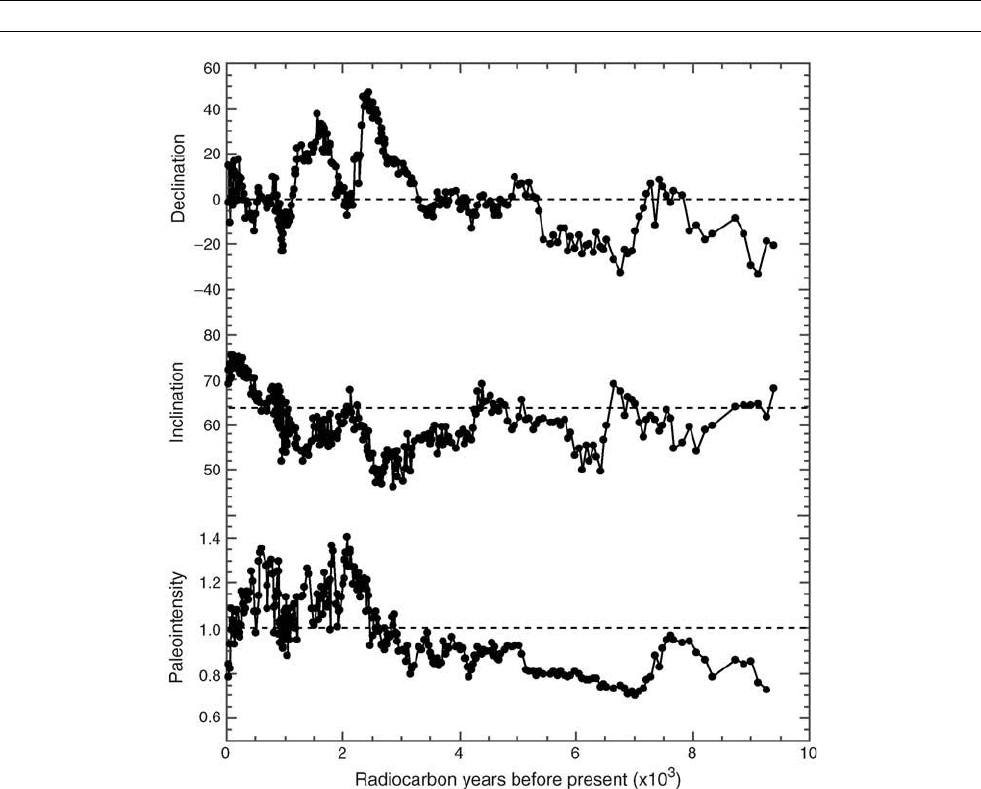
Time-series analysis of PSV
The conceptual framework for analysis of PSV data is based on
the fact that HSV records are too short in duration to adequately
characterize the totality of temporal field variability, while PSV
records are too scattered spatially to routinely describe the prehistoric
spatial field variability. We can hope, however, to identify spatial
and short duration temporal components of the HSV that may relate
to long-term temporal components of the PSV. We can also attempt
to improve the spatial estimates of PSV by, perhaps, appealing to
analogs in HSV. Such a coordinated analysis of PSV and HSV can
perhaps address a key to an unresolved question in secular variation
studies: What is the mapping function between the observed spatial
and temporal variations of the geomagnetic field? Only with a coher-
ent view of the total spatiotemporal variability of the historic and
prehistoric geomagnetic field can we properly evaluate models of the
core dynamo process, which is the source of the field variability.
Analysis of PSV data uses a variety of time-series and modeling
techniques in order to delineate the spatial and temporal characteristics
of PSV. Time-series techniques that can be applied to PSV data will be
considered in this section; modeling techniques will be considered in
the next section. Time-series techniques are classified into three broad
categories: waveform analysis, spectral analysis, and statistical analysis.
Each of these techniques has unique advantages for characterizing a par-
ticular type of PSV data and thereby providing a point of comparison
with HSV data.
Waveform analysis
PSV records that display good serial correlation between adjacent data
points (e.g., Figures P9-P12) can be used to assess the actual time evo-
lution of geomagnetic field variability. This time evolution can be
characterized either by evaluating simple PSV features, such as max-
ima or minima of inclination, declination, or paleointensity, or more
distinctive sets of features termed vector waveforms (Lund, 1996).
One type of vector waveform that may have fundamental importance
for dynamo studies is the vector-looping pattern termed circularity
(Runcorn, 1959. Skiles, 1970) often exhibited by HSV and PSV
records (e.g., Bauer, 1895. Creer, 1983. Lund, 1996). Comparisons
of simple features or vector waveforms may take place (1) within indivi-
dual paleomagnetic records, (2) between records of different sites, and
(3) between PSV and HSV records (where they overlap in time), and can
be used to assess the temporal evolution of secular variation. Compa-
risons of the amplitudes and phase relationships of PSV features
or waveforms with their spatial counterparts(?) in global maps of the
present-day field may be used to assess the spatial-temporal mapping of
secular variation. Below we discuss three different types of waveform
comparison that document distinctive PSV characteristics.
The first type of waveform comparison that should be considered
is between PSV records and HSV records from the same sites. For
example, Figure P9 shows a transect of PSV records for the last 3 ka
across Eurasia. Open circles in the interval
A.D. 1600 to A.D. 2000
estimate the historic secular variation for each site based on spherical
Figure P10 Holocene full-vector paleomagnetic secular variation record recovered from Lake St. Croix, Minnesota (USA) (Lund and
Banerjee, 1985; Lund and Schwartz, 1999).
768 PALEOMAGNETIC SECULAR VARIATION
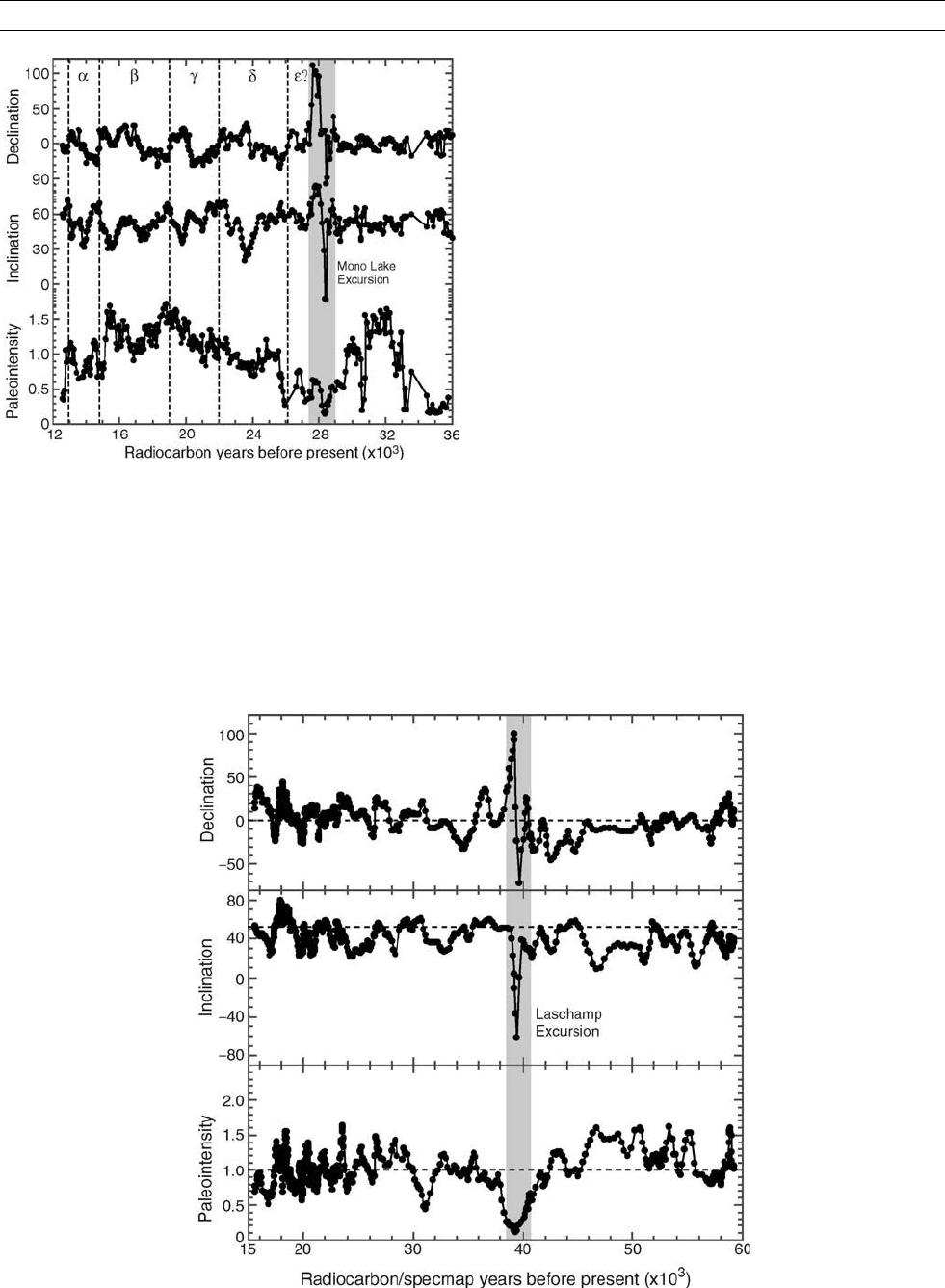
harmonic analyses. Such comparisons indicate that only the largest
amplitude, longest period (200–400 years) HSV features can be cor-
related with the PSV variability (indicated by solid circles in Figure P9).
This limited correlation is due to the fact that PSV records only resolve
features greater than about 4
in amplitude and a few hundred years
in duration. Even then, this correlation shows that high-resolution
PSV records can accurately record and extend the long-term temporal
variation only hinted at in HSV records.
The second type of comparison, between different high-resolution
PSV records from the same region (e.g., Europe or East Asia), can
be used to assess the spatial extent of PSV features. For example,
Figure P9 shows late Holocene PSV records from seven different sites
in Europe (Iceland, ICE to CAU) spread over 70
of longitude
(7000 km) and four different sites in East Asia (MON to Japan,
JPN) spread over 30
of longitude (3000 km). Within each of these
regions, it is readily apparent that a large number of directional features
can be correlated among the records. (i.e., not to say that the records are
identical, but variations in sampling rate and signal to noise ratios or
errors in data acquisition and analysis probably can explain most of
the differences in single records). One interpretation of these observa-
tions is that PSV features with periods longer than a few hundred years
must correspond to spatial features that are observable in historic maps
of the geomagnetic field and have spatial domains of several 1000 km.
A similar comparison between PSV records from different geo-
graphic regions is more problematic. For example, the comparison
between European and East Asian PSV records in Figure P9 indicates
that there is no simple correlation between directional records from
the two regions that preserves phase relationships or long-term trends
in the directional data. Similarly, there is no simple vector pattern that
Figure P12 Late Pleistocene full-vector paleomagnetic secular variation record from deep-sea piston core JPC-14, western north
Atlantic Ocean (Lund et al., 2001, 2005). Note the presence of the Laschamp excursion near 40000 years
B.P.
Figure P11 Late Pleistocene full-vector paleomagnetic secular
variation record recovered from uplifted lake sediments exposed
at Mono Lake, California (USA) (Liddicoat and Coe, 1979; Lund
et al., 1988). Note the presence of the Mono Lake excursion near
28000 radiocarbon years
B.P. and indication of at least four cycles
of a complex repeating vector waveform (a-E?) associated with the
excursion.
PALEOMAGNETIC SECULAR VARIATION 769
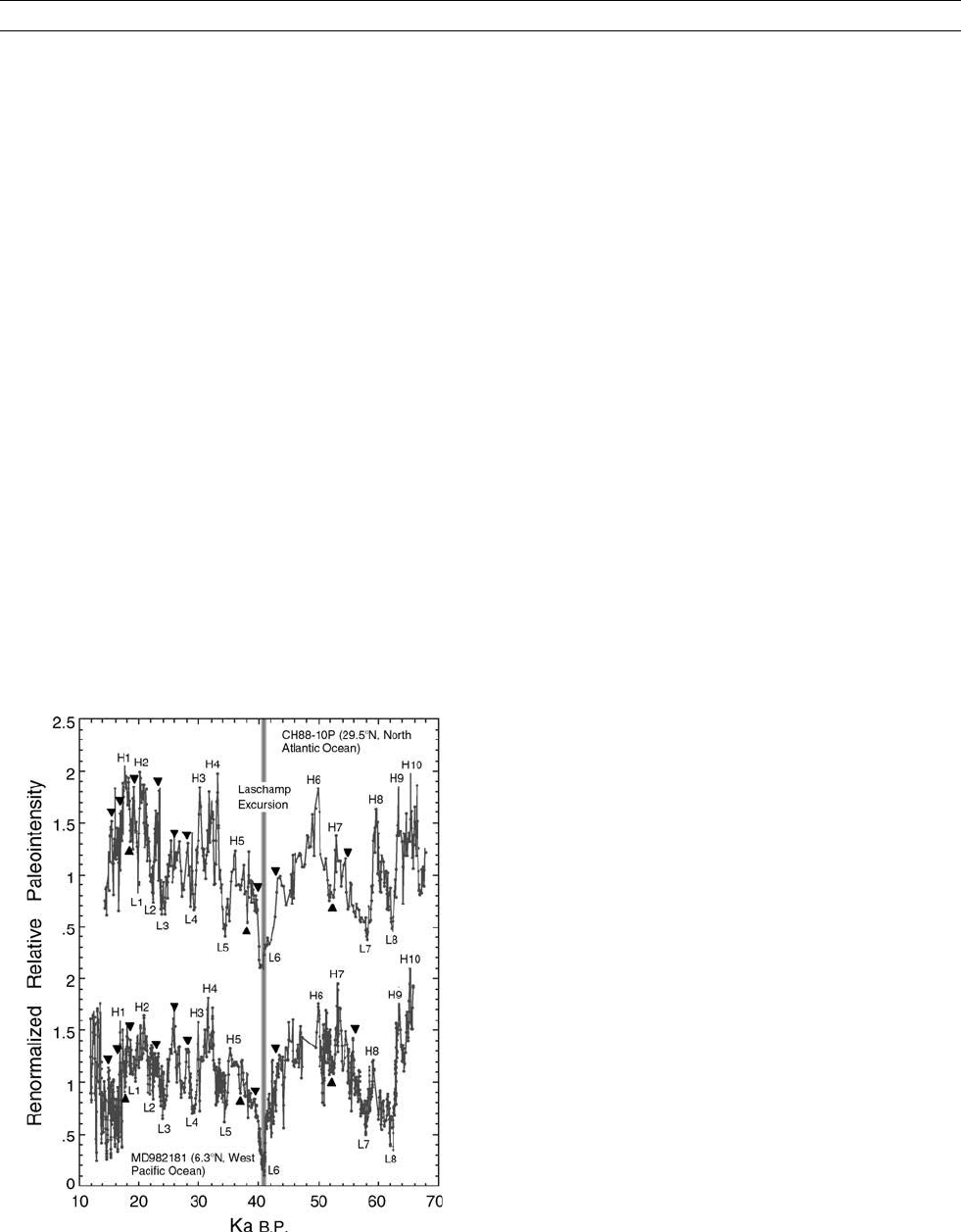
can be traced all the way across Eurasia for the last 3000 years. It thus
appears that straightforward PSV vector correlations break down
beyond perhaps 5000 km. Thompson (1984) noted a similar scale of
spatial coherence in the correlation of HSV waveforms. He determined
that HSV could be broken down into about nine different regions over
the Earth’s surface. Within each region, HSV waveforms are broadly
correlative, but between regions the patterns are significantly different
(and uncorrelated except for an overall vector average approximating
the axial dipole expectation). This lack of global-scale correlation
appears to be present in directional PSV records as well and indicates
that there is no persistent westward (or eastward) drift of distinctive
geomagnetic features over thousands of years, as has been suggested
most recently by Merrill et al. (1998).
Paleointensity, on the other hand, does show clear evidence of
global-scale coherence in its variability. Comparisons of paleointensity
records from around the world (e.g., Guyodo and Valet, 1999;
Laj et al., 2000; Stoner et al., 2003) show clear evidence that most
long-term (>1000 years) paleointensity variability is correlatable on
a global scale. For example, Figure P13 shows two high-resolution
relative paleointensity records recovered from deep-sea sediments on
almost opposite sides of the Earth (Stott et al., 2002). The records
identify 30 paleointensity features that are synchronous in age (500
years resolution) based on oxygen isotope age determinations, includ-
ing a distinctive paleointensity low associated with directional records
of the Laschamp Excursion at each site. One future task of PSV stu-
dies is to rationalize how significantly different patterns of directional
variability can exist around the world in the presence of such globally
coherent paleointensity variability.
A third type of waveform comparison can be made between PSV
features or vector waveforms within individual paleomagnetic records.
Such comparisons have occasionally identified distinctive vector
waveforms that seem to recur every 2500 to 4000 years. The PSV
record from Mono Lake, shown in Figure P11, illustrates this recur-
rence pattern. At least four recurrences (a-d) of basically the same
complex waveform can be noted (Lund et al., 1988). With each
recurrence, the waveform is slightly altered; however, the general pat-
tern persists for more than 16 ka. It is likely that this distinctive
waveform has evolved out of the Mono Lake excursion (waveform
E?inFigure P11). Similar recurring patterns have been noted in the
Holocene PSV record from Lake St. Croix (Figure P10; Lund and
Banerjee, 1985) in a late Pleistocene PSV record from Russia (Ekman
et al., 1987), and after the Summer Lake Excursion recorded in lake
sediments from Oregon (Negrini et al., 1994).
Recurring vector waveforms can also be identified by their distinc-
tive sequences of vector looping (circularity). Such looping patterns
(Runcorn, 1959) are characteristic of both PSV (e.g., Creer, 1983)
and HSV (e.g., Bauer, 1895) and have been suggested (Skiles, 1970)
to be an indicator of westward or eastward drift of the geomagnetic
field (although there is no significant evidence of long-term persistent
drift of the field as noted above). However, the correlation between
observed looping and drift is not unique (Dodson, 1979). Large ampli-
tude loops, often associated with recurring vector waveforms, last
about 1000 to 1400 years; small amplitude loops have also been noted
that last about 500– 800 years. Looping intervals might be used as
an indicator of the simplest temporal scale for PSV coherence at
individual sites.
Excursions
One type of vector waveform deserves special note—magnetic field
excursions, which are anomalous PSV fluctuations defined by virtual
geomagnetic poles (VGPs) located more than 45
away from the
geographic pole. It is clear that excursions do occur; it is often not
clear, however, what is their waveform morphology or whether some
excursions are really artifacts of field-laboratory measurement errors.
There is growing evidence (e.g., Lund et al., 2001, 2005) that at least
seventeen excursions have occurred in the Brunhes Epoch (0–780000
years
B.P.). One distinctive element of all these excursions is that they
occur within intervals of anomalously low global-scale paleointensity
(see Figures P11-P13). Most excursion records are difficult to corre-
late around the world because of uncertainties in their age estimates.
But, three of the most recent excursions are becoming better under-
stood: the Mono Lake excursion (CA. 28000 years
B.P.; Denham and
Cox, 1971; Liddicoat and Coe, 1979; Figure P11), The Laschamp
excursion (CA. 41000 years
B.P.; Bonhommet and Zahringer, 1969;
Figures P12 and P13) and the Blake Event (CA. 125000 years
B.P.;
Smith and Foster, 1969). For each of these excursions, there are now
multiple independent records from around the world, which are suffi-
ciently well dated to correlate the records and estimate that individual
excursion records are synchronous to 500-year resolution. There are
also a number of high-resolution excursion records (e.g., Liddicoat and
Coe, 1979; Lund et al., 2005.rpar; that assess the local waveform pat-
terns of excursions and the surrounding normal PSV. However, there
are still not enough high-resolution excursion records to be certain
about their global pattern of field variability or relationship to normal
PSV or magnetic field reversals.
Spectral analysis
Spectral analysis describes the frequency content of PSV over time-
scales of 10
2
–10
5
years. Traditional ideas suggest that PSV should
be a band limited process. That is, that the spectral power of PSV
should markedly diminish beyond some cutoff period on the order of
10
4
years. PSV records longer than the cutoff period should then be
stationary in a statistical sense and have an average field vector direc-
tion that is constant through time for a given site. The axial dipole
hypothesis, a cornerstone of plate tectonic reconstructions, assumes
that the PSV process is stationary and that each site’s average field
vector (during intervals of normal polarity) satisfies the formula,
Figure P13 Late-Pleistocene paleointensity comparison between
sediment PSV records from the North Atlantic Ocean and western
Equatorial Pacific Ocean (Stott et al., 2002). A number of distinctive
and correlatable paleointensity features are noted in the two
records; independent oxygen isotope stratigraphies suggest that
these features are synchronous (500 year uncertainty).
770 PALEOMAGNETIC SECULAR VARIATION
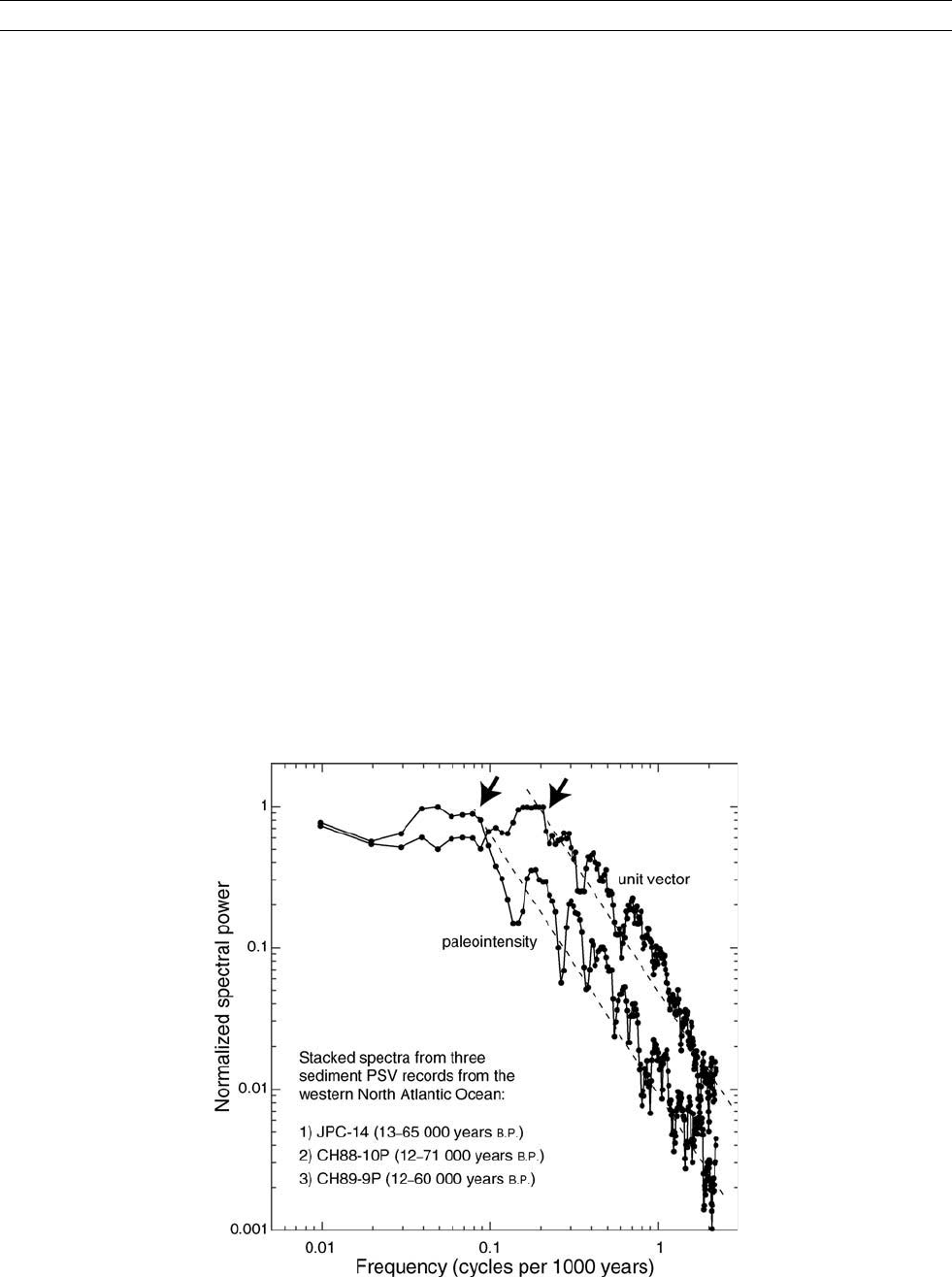
tanI ¼ 2tanl, D ¼ 0
, where l is the site paleolatitude. One important
goal of PSV studies is to test the long-term validity of the axial dipole
hypothesis and the notion of a stationary PSV spectrum with limited
power at >10
4
years.
Spectral analysis also describes the characteristic distribution of
continuous spectral power within the overall PSV process (Barton,
1982, 1983) and identifies whether there are distinct frequency bands
within the continuous spectrum that have higher than average spectral
power. Knowledge of the PSV power spectrum and its potential
changes in time and space is critical for better understanding the rela-
tionship between PSV and the core dynamo process that generates it.
The primary limitation in recovering detailed estimates of the
PSV spectrum is the quality of age estimates associated with the PSV
records. Records dated using radiocarbon methods over the last
40 ka or so may have systematic errors with respect to “true” time due
to radiocarbon reservoir effects. They may also have random errors on
the order of 10
2
years or worse due to random dating errors. Older PSV
records can also be dated using oxygen isotope stratigraphies, but such
age estimates have random uncertainties on the order of 10
3
years.
Despite these limitations, important and convincing spectral esti-
mates of late-Quaternary PSV have been recovered from several
regions around the world: Europe, North America, the Far East,
Australia, and South America. Figure P14 shows the stacked PSV
spectrum of unit-vector (RMS of scalar inclination and declination
spectra) and paleointensity results from three deep-sea sediment PSV
records in the western North Atlantic Ocean that are >50 ka in dura-
tion. These results provide a good overview of the long-term PSV
spectrum. The unit-vector and paleointensity spectra are continuous
in their power distribution, with the largest amplitude secular variation
occurring at periods much greater than 10
3
years (far beyond the range
of HSV). Both spectra are red (power-law relationship between fre-
quency and power) for periods <5ka–12 ka, and white (constant
power as a function of frequency) for longer periods with no indication
of a marked decrease in spectral power at the longest observed periods
(50 ka). These characteristics suggest that the geomagnetic field is not
stationary (band-limited) over timescales of less than about 10
5
years.
The corner frequencies (boundaries between dominantly red and white
spectra, indicated by arrows in Figure P14), are about 5 ka for the unit-
vector spectrum and about 12000 years for the paleointensity spectrum.
One interpretation of the corner frequency is that the red spectrum
describes the intrinsic dynamics of field variability associated with
the dynamo process, while the white spectrum describes random pertur-
bations of that process or longer-term external forces acting on that
process (e.g., Channell et al., 1998). In this scenario, the corner
frequency in paleointensity of 12 ka defines the longest time constant
of normal dynamo activity. The fact that the unit-vector corner fre-
quency is only 5 ka is due to the observation that vector variations
only reflect nonaxial dipole field variability, not total field variability.
It is probably not coincidental that the longest repeating vector wave-
forms noted in individual PSV records approach the unit-vector corner
frequency of 5 ka. There is also evidence of selected spectral bands
in the red portion of the spectra with larger than average spectral
power. That is the pattern noted in most other PSV spectra determined
from shorter duration records (e.g., Barton, 1982, 1983). These spectral
bands probably define the detailed pattern of dynamo activity in a
region at any one time, but none of these components are probably per-
iodic on a long-term spatial or temporal scale and they should tend to
smear out when spectra from different time intervals or spatial regions
are stacked.
Most of these spectral characteristics have no temporal analog in
HSV because of the short time span of historic measurement. One
might, however, attempt to relate the long-term PSV spectral charac-
teristics to the present day geomagnetic field spatial spectrum. The
spatial field due to core sources has a cutoff near spherical harmonic
degree 12 and the spectral power decreases quickly from a maximum at
harmonic degree 1 (dipole terms). Only spatial terms of about degree 6
or less have vector amplitudes large enough to be recorded in PSV., One
might therefore hypothesize that the long-term PSV spectrum must be
Figure P14 Paleointensity and unit-vector spectra for a stack of three long-term deep-sea sediment PSV records from the western North
Atlantic Ocean. One of the records, JPC-14, is shown in Figure P12. Arrows indicate corner frequencies, which separate “white” and
“red” portions of the spectra.
PALEOMAGNETIC SECULAR VARIATION 771
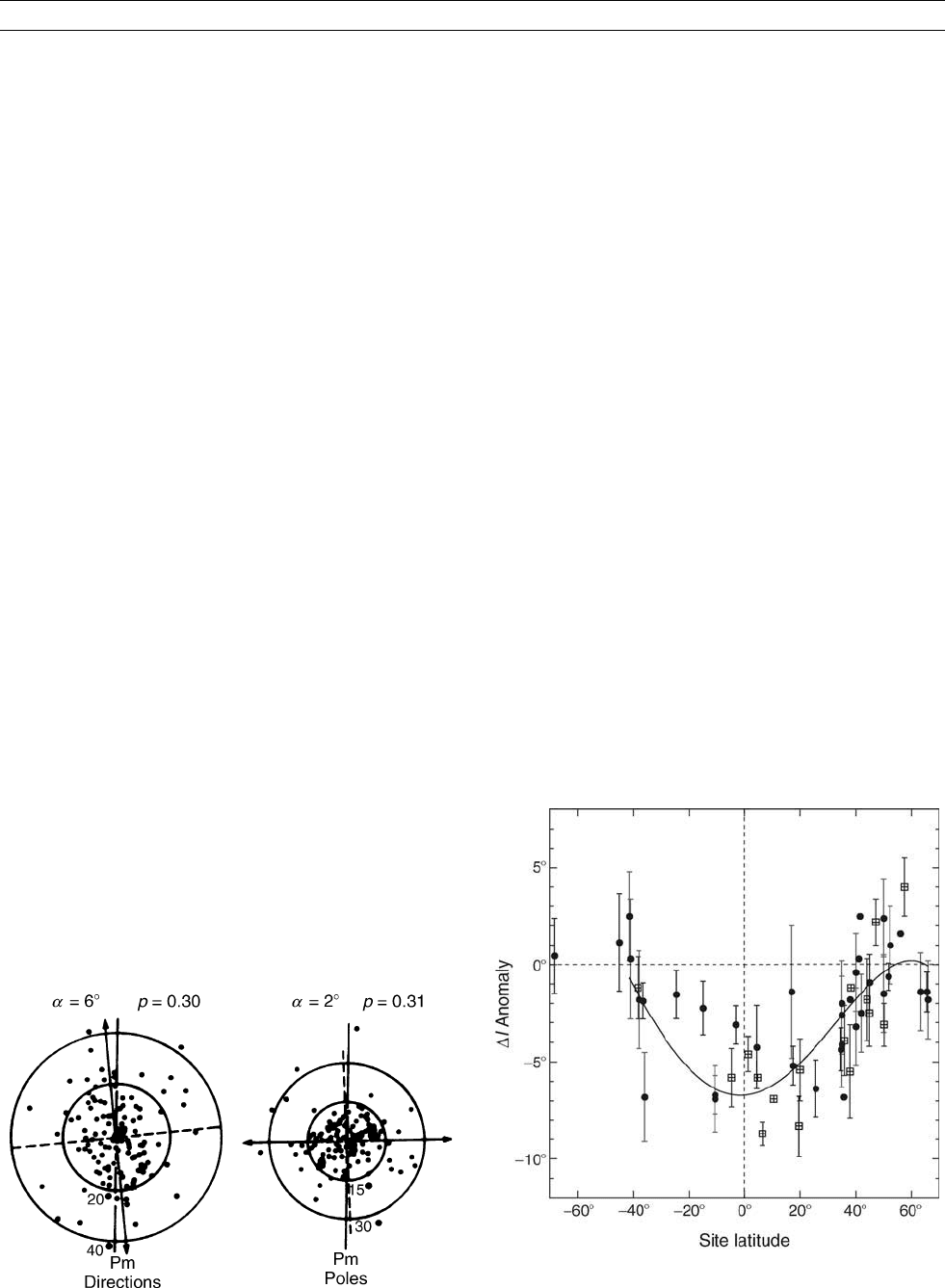
due to temporal variations of spatial components of the present-day field
with spherical harmonic degree 5–6, under normal conditions.
Statistical analysis
The aspect of PSV that is easiest to analyze is its statistical behavior
averaged over some interval of time. For this reason, statistical proper-
ties of PSV, within time windows in the order of 10
5
or 10
6
years, were
the first PSV characteristics to be compared spatially, and even today
they are the only PSV characteristics that can be easily compared on a
global scale. Such comparisons provide the strongest evidence relating
to possible long-term stationarity of geomagnetic field behavior,
the axial dipole hypothesis, and the potential global pattern of selected
PSV characteristics. Statistical study of PSV follows two very different
paths on the basis of sampling frequency and age control of the paleo-
magnetic measurements. In the first approach, paleomagnetic field
directions in undated rock sequences are measured under the assump-
tion that the age difference of successive rock units is large compared
to the longest period of PSV (often assumed to be about 10000 years).
Each data point is therefore assumed to be an independent random value
picked from an assumed frequency-band-limited PSV process. Data sets
from small regions, averaged over 10
5
or 10
6
years, are then statistically
analyzed and compared with some global model of the expected statis-
tical behavior. (Even if the underlying assumptions of spectral content
are wrong, as they likely are, results from this type of statistical analysis
should not be seriously biased if the data are truly randomly spaced in
time.) The second approach is to measure well-dated (either by radio-
carbon or oxygen isotope methods) paleomagnetic sequences where
the sampling interval is less than the shortest period of PSV (about
30 years). It is not often feasible to find sequences with such short time
spacing, but useful information can be obtained with sample intervals up
to perhaps 250 years (and even longer under special circumstances).
Statistics are estimated from equispaced time-series derived from the
dated paleomagnetic records. This method permits spatial comparison of
statistical parameters averaged over much shorter time intervals, on the
order of 10
3
–10
5
years. In such studies, it is likely that the statistics does
not represent a “stationary” estimate of space-time field variability but
rather a “statistical snapshot” of an evolving space-time field structure.
Statistical analyses of the probability distributions of both field vec-
tors and their equivalent VGPs from single sites indicate that neither
distribution is typically Fisherian (Fisher, 1953; spherical analog of
the Gaussian or normal distribution). For example, Brock’s (1971)
results from equatorial Africa (Figure P15) show that both field vectors
and VGPs tend to have somewhat elliptical distributions. Engebretson
and Beck (1978) have summarized the statistical parameters normally
used to characterize the shape of the probability distribution. It is
probable that shape statistics vary systematically as a function of
latitude (and longitude?) and future studies of shape statistics may pro-
vide important added characteristics of the Earth’s long-term PSV. As
a starting point, it is worth noting that the range of vector variability
(as a function of latitude) noted in historic maps of the geomagnetic
field is comparable to the range of vector variability noted in indivi-
dual PSV records from the late Quaternary. This suggests that, even
though secular variation changes on timescales far beyond the range
of historic measurements, the normal range of its spatial variability is
completely present in the observed historic field. A similar observation
has been made for the long-term pattern of PSV angular dispersion by
McFadden et al. (1988).
Currently, the two statistical parameters most often measured in
PSV studies are the DI anomaly, which is the site mean inclination
minus the expected axial dipole field inclination and the angular dis-
persion associated with a site’s vector (or equivalent VGP) variability.
The global pattern of the DI anomaly estimates how well the axial
dipole hypothesis, the cornerstone of plate tectonic reconstructions, fits
the actual geomagnetic field behavior. The global pattern of angular
dispersion should provide some measure of the spatial pattern of
intrinsic “energy” or “dynamics” in the core dynamo process. This
variability may be due to differing proportions of dipole versus nondi-
pole field variability (see summary in Merrill et al., 1998) or it could
be interpreted as the relative importance of primary versus secondary
family spherical harmonic components (McFadden et al., 1988), two
orthogonal components of the geomagnetic field that may have funda-
mental relationships to dynamo theory (Roberts and Stix, 1972).
The DI anomaly was perhaps first quantified by Wilson in 1970 who
noticed that the average paleomagnetic pole positions associated with
individual geographic regions (e.g., Australia, Europe, North America)
were always farther from the sampled region than the known
geographic pole. This offset, termed the farsided effect, is due to
paleomagnetic inclinations that are systematically more negative than
their axial dipole expectation (negative DI anomaly), on average.
McElhinny et al. (1996) have determined the global DI anomaly for
the last 5 Ma (see Figure P16), on average, and noted that the DI
anomaly is mostly negative with a maximum anomaly near the Equa-
tor and a latitudinal variation that is symmetric about the Equator and
Figure P15 Statistical distribution of PSV directions and virtual
geomagnetic poles (VGPs) from Equatorial Africa (Brock, 1971).
Figure P16 DI anomaly as a function of latitude for selected
time intervals: solid symbols—last 5 Ma average, open circles
last few thousand years average, open squares, last 10–20 ka
average.
772 PALEOMAGNETIC SECULAR VARIATION
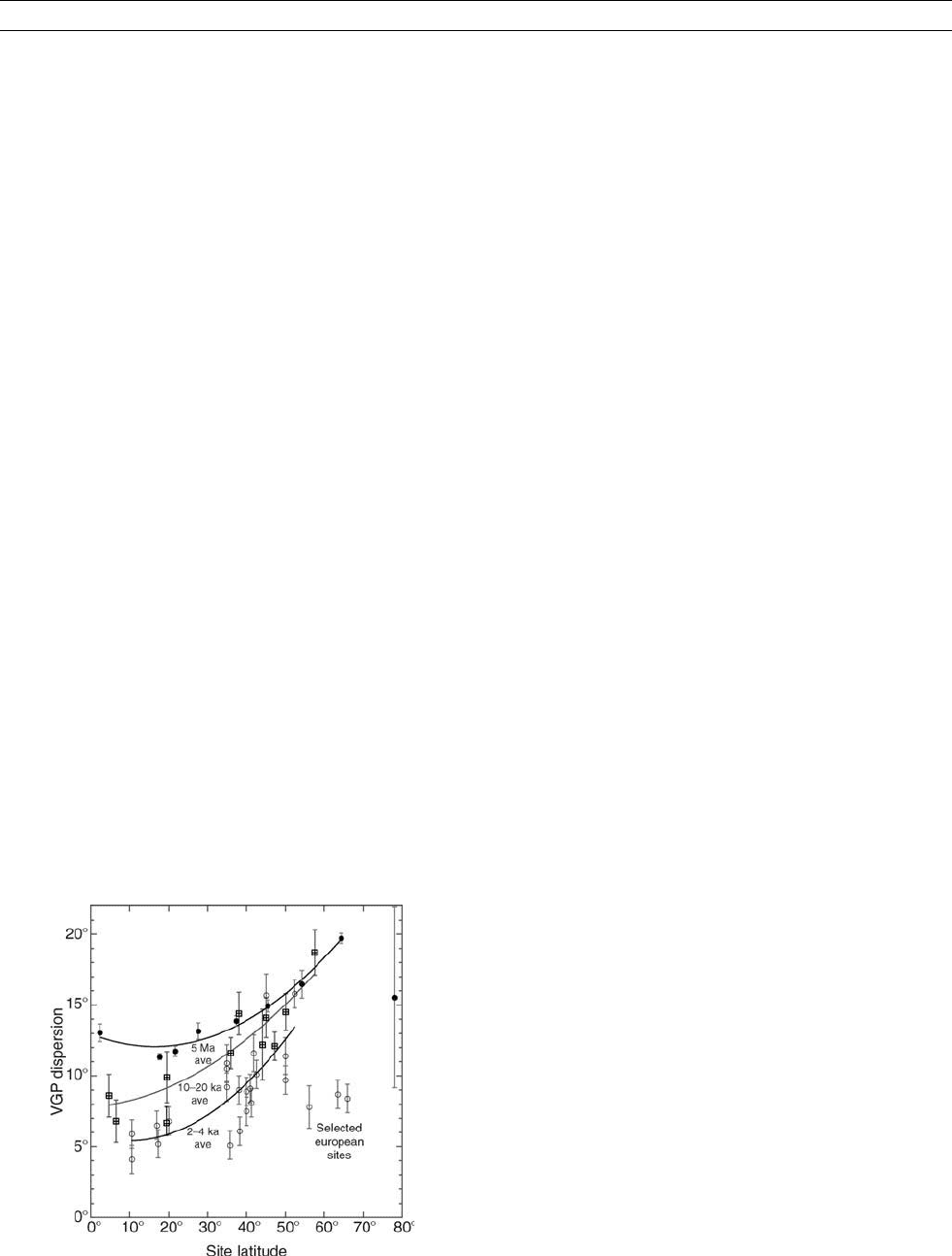
zonal (any site along a line of latitude will have the same magnitude of
DI anomaly). Their analysis also indicated that DI anomaly has
persisted with the same general pattern and magnitude for the last
5 Ma during both normal and reversed polarity. Other workers (e.g.,
Coupland and Van der Voo, 1980; Livermore et al., 1984; Schneider
and Kent, 1990) have noted that a similar pattern of DI anomaly has
persisted for at least the last 100 million years, but with slow variations
in the maximum anomaly magnitude. Statistical studies of shorter-term
equispaced PSV time-series (e.g., Lund, 1985; Lund et al., in review)
indicate that the DI anomaly averaged over 10
3
years (see open circles
in Figure P16) and 10
4
years (see open squares in Figure P16) also
show the same general DI anomaly pattern noted in the longer-term
data. However, Constable and Johnson (2000) have argued that nonzo-
nal components of the DI anomaly are significant and have persisted
for the last several million years, with some Equatorial regions having
more significant DI anomalies than other regions and some high-
latitude regions actually having positive DI anomalies. These observa-
tions all suggest that the spatial pattern of the DI anomaly is persistent
but nonstationary in its detailed pattern over timescales greater than
10
4
years. The implication of the DI anomaly for plate tectonic stu-
dies is that paleolatitude estimates derived from paleomagnetic studies
may be in error by as much as 8
depending on time and paleolatitude.
Similar analyses of declination have shown no significant deviations in
declination values from 0
over the last several million years.
Analysis of PSV angular dispersions (either directions or their
equivalent virtual geomagnetic poles, VGPs) has established that this
parameter also displays a distinctive zonal pattern of amplitude varia-
tion with latitude. The average latitudinal pattern of VGP angular
dispersion for the last 5 Ma (McFadden et al., 1988) is shown in
Figure P17. Lund (1985) and Lund et al. (in review) have noted, how-
ever, that VGP angular dispersion averaged over 10
3
and 10
4
year inter-
vals (open circles and open squares in Figure P17) using equispaced
PSV time-series is significantly lower than the 5 Ma average, and Merrill
and McFadden (1988) have shown that it can vary on much longer
(10
7
year) timescales as well. A variety of parametric models, summar-
ized in Merrill et al. (1998), have been developed to attempt to explain
the observed spatial pattern of angular dispersion in an ad hoc manner.
More recently, McFadden et al. (1988) were able to relate the long-term
average pattern of VGP angular dispersion to historical field observa-
tions and developed model G, based on the relative importance of pri-
mary versus secondary family magnetic field components (Roberts and
Stix, 1972), to explain the latitude dependence.
These statistical observations indicate clearly that PSV varies in a
nonstationary manner over a variety of timescales, a pattern consistent
with the PSV spectrum described above, and may be related to the
continuing time evolution of regional PSV waveforms. One discordant
note in this discussion of PSV nonstationarity is the qualitative sense
that, even though PSV statistics may vary quantitatively in a nonpre-
dictable manner over time, the PSV vector mean for any site is heavily
“attracted” to its axial dipole expected direction. This may be due to
the symmetry associated with the Earth’s rotation, one of the driving
forces of the dynamo. But, whatever be the cause, it seems prudent,
perhaps, to think of PSV as “quasi-stationary” in its behavior based
on the overall sense of “attraction” to such a “fixed point” (the axial
dipole expectation) in time and space.
Models of PSV
An alternative method for the analysis of PSV is to develop models for
the observed field variability. Such models may be conceptual in
nature with their primary purpose being to qualitatively estimate the
style of variability that a potential dynamo source might generate, or
the models may be more quantitative (essentially mathematical simula-
tion models), with their primary purpose being to replicate observed
PSV. The mathematical simulation models may be developed from
more conceptual models, with sources that may have some basis in
reality, or purely from empirical (unrealistic) inputs. A third group of
models that characterize the actual hydromagnetic process that gener-
ates the Earth’s core field is beyond the scope of this survey.
Conceptual models
Previously, various conceptual models have been proposed to qualita-
tively explain characteristic features of HSV. Three models that have
been discussed most often are (1) dipole wobble, (2) westward
(or eastward) drift of the total nondipole field, and (3) standing and
drifting nondipole fields. These conceptual models have also been
called upon to qualitatively explain specific components of PSV or
to justify and physically explain specific mathematical simulation
models of PSV.
Dipole wobble has been suggested as one component of HSV and
PSV based on the presence of an 11.5
offset in the present day dipole
field, its persistence during historic time, and the indication from
paleomagnetic data that the field has an average declination of 0
over
timescales of 10
4
years or longer. Therefore, the average dipole field
direction must have moved prehistorically and perhaps it has
“wobbled” irregularly.
The paleomagnetic evidence for dipole wobble is problematic
because of non uniqueness. PSV at a single site is really the nonaxial
dipole variation (dipole wobble plus true nondipole variation) at that
site. The proportion of dipole wobbles versus true nondipole contribu-
tions to PSV can only be assessed by analyzing globally distributed
paleomagnetic data. Merrill and McElhinny (1983) carried out such
an analysis of Northern Hemisphere archeomagnetic data for the last
2000 years and suggested that a significant dipole wobble component
does exist. Dipole wobble contributions have also been estimated from
the statistical analysis of angular dispersion (e.g., McFadden et al.,
1988); however, the proportion of dipole wobble depends upon the
proposed model of dipole wobble variability.
Westward drift has been suggested as an important element of HSV
based on the observation that temporal changes in nondipole field
components at the Earth’s surface are due primarily to the westward
drift in time of the spatial nondipole field components. The cause of
westward drift has been related to differential rotation of the fluid outer
core, where the field is generated, versus the overlying lithosphere.
The importance of westward drift is complicated by the fact that some
areas of the Earth have exhibited eastward drift and other areas have
exhibited no drift at all during historic times (e.g., Thompson, 1984).
Paleomagnetic evidence for westward drift comes from a variety of
Figure P17 VGP angular dispersion as a function of latitude
for selected time intervals: solid symbols—last 5 Ma average,
open circles last few thousand years average, open squares, last
10–20 ka average.
PALEOMAGNETIC SECULAR VARIATION 773
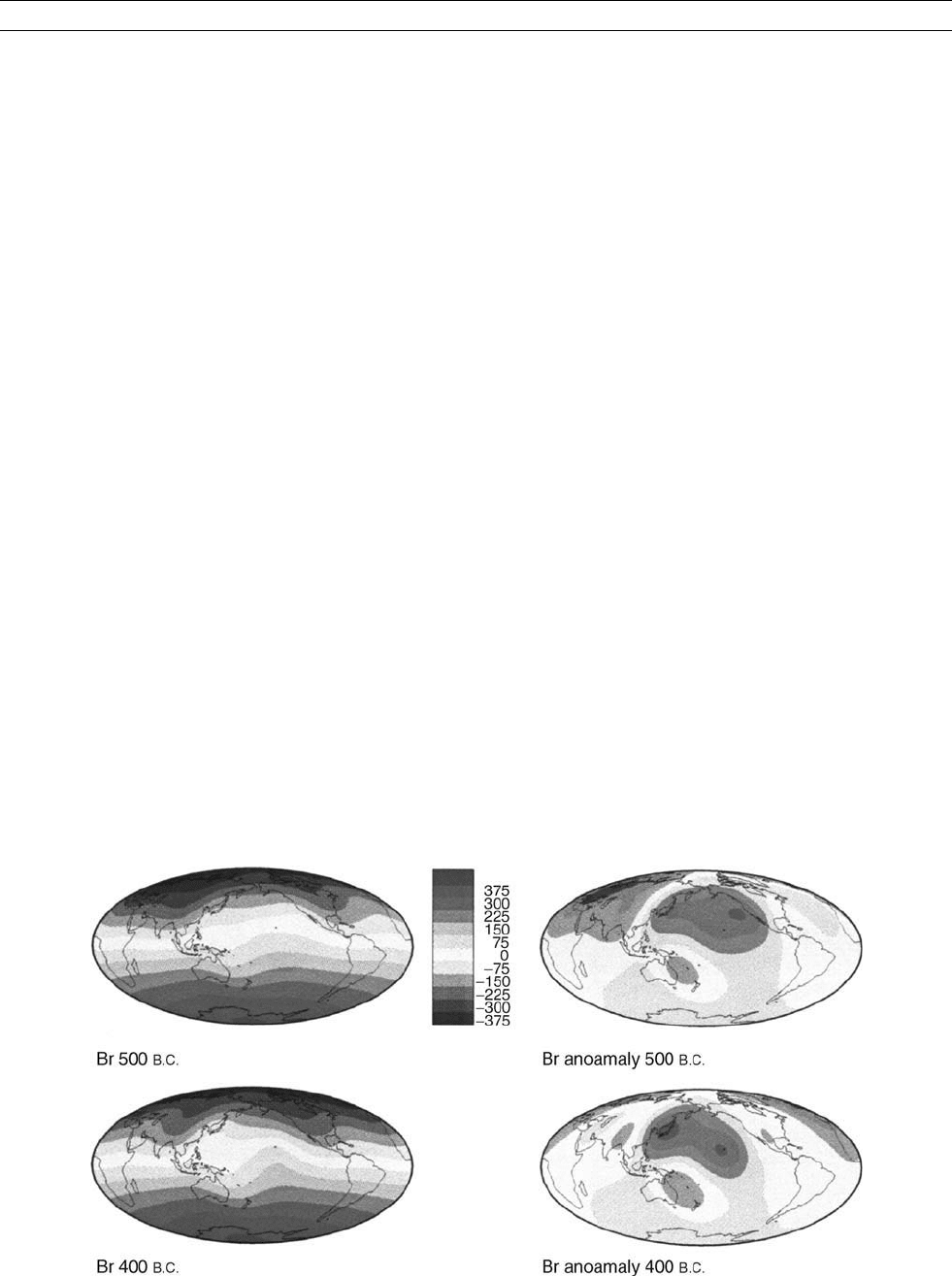
PSV observations, of which a few are unique. The circularity of PSV
data has long been associated with westward or eastward drift of the
paleomagnetic field, although other nonaxial dipole variations could
produce the same effect. The recurring waveforms, noted earlier,
may indicate westward (or eastward) drift of a complex nondipole
waveform that changes very slowly in time compared to the time it
takes for the waveform to drift entirely around the Earth (2500–
4000 years). In such a model, similar waveform and spectral character-
istics should be noted at all sites along a line of latitude. The Holocene
waveform comparisons noted earlier, however, do not appear to be
compatible with this model. Regional PSV comparisons within Europe,
East Asia, or North America separately display waveform correlations
that are consistent with a westward drift model; however, no simple
correlation can apparently be made between the three regional data
sets. Such a correlation between regional PSV records is necessary if
persistent westward (or eastward) drift is a predominant aspect of PSV.
Standing nondipole field components have been proposed to
improve the fit of drifting nondipole field components to the total
HSV. If truly present, their origin might be related to standing compo-
nents of fluid flow near the core mantle boundary caused by irregula-
rities in the boundary conditions. The presence of standing nondipole
components in the paleomagnetic record, however, is very difficult
to evaluate because of problems of nonuniqueness and the uncertain-
ties of spatial PSV behavior. To the extent that standing nondipole
components might produce nonzonal components of I and D, their
importance must be below the level of noise associated with para-
metric statistical analyses of long-term PSV (average I, D; AI; angular
dispersion), for all of these parameters are apparently zonal in their
spatial distribution. However, in the study of late Quaternary PSV wave-
forms, standing nondipole sources have been suggested as reasonable
(but nonunique) alternatives to westward drift to explain the observed
waveform variability within individual paleomagnetic records.
Mathematical simulation models
Models that are more quantitative have also been applied to HSV and
PSV. Spherical harmonic models separate the field into dipole and
nondipole components and may include secular change coefficients
for predicting short-term temporal variations. The primary drawback
to spherical harmonic models is their general lack of relevance to the
underlying physical causes of the Earth’s internal magnetic field.
(The exception to this may be the separation of spherical harmonic
coefficients into primary and secondary family field components.)
Models based on the variability of multiple localized sources in the
outer core have occasionally been used as alternatives to spherical
harmonic models. These models, which may use a distribution of
dipoles, current loops, or wave patterns in their formulation, are more
appealing in that those sources may mimic that part of the core process
associated with observed nondipole foci observed at the Earth’s surface
(e.g., Thompson, 1984).
Spherical harmonic models are hard to apply to PSV because of the
inherent timing uncertainties associated with PSV data and because of
the poor spatial distribution of most PSV data. Even so, several recent
summaries of PSV for the last few thousand years (e.g., Hongre et al.,
1998; Constable et al., 2000; Korte and Constable, in press), based on
worldwide (but poorly distributed) sites, have begun to give us a low-
degree spherical harmonic view of PSV. Figure P18, for example,
shows the geomagnetic field radial flux (Br) and non-axial dipole
radial flux (Br-anomaly) at the core-mantle boundary for two prehistoric
epochs based on SHA of PSV time-series (Constable et al., 2000).
The advantage of PSV derived SHA data sets is that they can be tied to
HSV derived SHA data sets and used to extend our view of the true glo-
bal-space-time pattern of secular variation back thousands of years
beyond the range of HSV. In this way, we can finally begin to address
the global space-time pattern of secular variation on scales appropriate
to the dynamics of PSV and the geodynamo.
Historically, time-averaged PSV statistical parameters, such as the
DI anomaly and vector dispersion, have been more amenable to
time-averaged spherical harmonic analysis. For example, the DI
anomaly can be modeled by an axial dipole with added quadrupolar
and octupolar components; the long-term changes in DI can then
be modeled as changes in the quadrupole-octupole (or primary-
secondary family) amplitude ratio. (See Merrill and McElhinny
(1983) for more detailed discussion.)
Localized dipole-current-loop models, with either standing or drift-
ing sources, have been applied to individual high-resolution PSV
records, as well as to statistical PSV records. An example of a drifting
radial dipole model for the Lake St. Croix PSV record (Figure P10;
Lund and Banerjee, 1985) is shown in Figure P19. Two drifting radial
dipoles plus an axial dipole are able to model almost all of the
Figure P18 Models of geomagnetic field radial flux (Br) and nonaxial dipole radial flux (Br-nad) at the core-mantle boundary for two
prehistoric epochs, 500
B.C. and 400 B.C. The models are the result of downward continuation of spherical harmonic models of PSV data
from Constable et al. (2000).
774 PALEOMAGNETIC SECULAR VARIATION
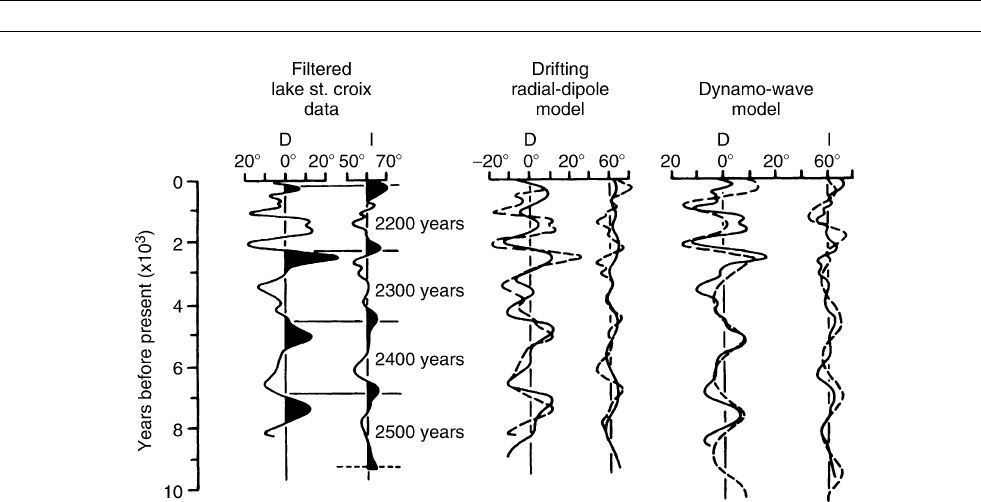
observed variability at Lake St. Croix for the last 9 ka. Unfortunately,
more complicated standing radial dipole models could also fit the
data. But, these models would require more sources in order to fit
the characteristic phase relationships of the Lake St. Croix PSV data.
The drifting radial dipole model for Lake St. Croix predicts similar
PSV behavior for other sites on Lake St. Croix’s latitude; the standing
radial dipoles model will only produce regional coherence. The diffi-
culty in correlating the Lake St. Croix PSV record with other global
records outside of North America argues that a drifting radial dipole
model is probably not appropriate to explain recurring waveforms.
However, the complex recurrent waveforms noted in several PSV
records are very difficult to model with standing sources due to
the number of sources required and the detailed timing of recurrent
intensity variations that each source must maintain relative to the
other sources.
An alternative model of PSV, based on poleward migrating dynamo
waves in the Earth’s outer core, has been developed by Olson and
Hagee (1987). Figure P19 shows the results of their model applied
to the observed Lake St. Croix PSV. It is apparent that the poleward-
migrating dynamo-wave model does just as good a job of fitting the
observed variability as the drifting radial-dipole model. The dynamo
wave model, however, only requires regional coherence in waveform
correlations, but not a global-scale correlation. Hagee and Olson
(1989) have also applied this dynamo wave model to a global set of
Holocene PSV records and shown that the same general pattern of
dynamo-wave variability noted to Lake St. Croix, can also explain
all other Holocene PSV around the world.
Steve P. Lund
Bibliography
Barton, C.E., 1983. Analysis of paleomagnetic time series-techniques
and applications. Geophysical Surveys, 5: 335–368.
Bauer, L.A., 1895. On the distribution and the secular variation of
terrestrial magnetism, No. III. American Journal of Sciences,
50: 314.
Bloxham, J., and Gubbins, D., 1985. The secular variation of Earth’s
magnetic field. Nature, 317: 777–781.
Bloxham, J., and Roberts, P., 1991. The geomagnetic main field and
the geodynamo. Reviews of Geophysics, 29: 428–432.
Bonhommet, N., and Zahringer, J., 1969. Paleomagnetism and
potassium-argon age determinations of the Laschamp geomagnetic
polarity event. Earth and Planetary Science Letters, 6: 43s.
Brock, A., 1971. An experimental study of paleosecular variation.
Geophysical Journal of Royal Astronomical Society, 24: 303.
Butler, R., 1992. Paleomagnetism: Magnetic Domains to Geologic
Terranes, London: Blackwell Publishers, 321 pp.
Cande, S.C., and Kent, D.V., 1995. Revised calibration of the geomag-
netic polarity timescale or the late Cretaceous and Cenozoic. Jour-
nal of Geophysical Research, 100: 6093–6095.
Champion, D.E., 1980. Holocene geomagnetic secular variation in the
western United States: implications for the global geomagnetic
field (Open file report 80–824), U.S. Geological Survey, 314 pp.
Channell, J., Hodell, D., McManus, J., and Lehman, B., 1998. Orbital
modulation of geomagnetic paleointensity. Nature, 394: 464–468.
Clement, B.M., and Kent, D.V., 1987. Short polarity intervals within
the Matuyama: transitional field records from hydraulic piston
cored sediments from the North Atlantic. Earth and Planetary
Science Letters, 81: 253–264.
Clement, B., and Constable, C., 1991. Polarity transitions, excursions,
and paleosecular variation of the Earth’s magnetic field. Reviews of
Geophysics, 29: 433–442.
Constable, C., Johnson, C., and Lund, S., 2000. Global geomagnetic
field models for the last 3000 years. Philosophical Transactions
of the Royal Society of London A, 358: 991–1008.
Creer, K.M., 1983. Computer synthesis of geomagnetic paleosecular
variations. Nature, 304: 695–699.
Denham, C.E., and Cox, A., 1971. Evidence that the LAschamp polar-
ity event did not occur 13300–30400 years ago. Earth and Plane-
tary Science Letters, 13: 181–190.
Dodson, R.E., 1979. Counterclockwise precession of the geomagnetic
field vector and westward drift of the nondipole field. Journal of
Geophysical Research, 84: 637.
Dunlop, D., and Ozdemir, O., 2001. Rock Magnetism, Cambridge:
Cambridge University Press, 596 pp.
Ekman, I., Bakhmutov, V., and Zagniy, G., 1987. Stratification and
correlation of varved clays in terms of the fine paleostructures of
the Earth’s magnetic field, In Kabailiene, M. (ed.), Methods for
the Investigation of Lake Deposits: Paleoecological and Paleocli-
matological Aspects, Academy of the Sciences of the Lithuanian
SSR, Vilnius.
Figure P19 Radial-dipole and dynamo-wave models of the Lake St. Croix PSV record.
PALEOMAGNETIC SECULAR VARIATION 775
